Page 320 of 440

320 Practical hintsWhat to do if …?Symbol messagesDisplay symbol
Display message
Possible cause
Possible solution
#
Undervoltage
Charge battery
The battery has insufficient voltage.
�
Start the engine (
�page 43).
Undervoltage
Switch off
consumers
The battery has insufficient voltage.
�
Turn off unnecessary electrical con-
sumers.
VISIT WORKSHOP!
The battery was charged with a battery
charger or jump started.
�
Have the battery checked at a service
station.
The battery is no longer charging.
Possible causes:�
alternator malfunctioning
�
broken poly-V-belt
Do not forget that the brake system re-
quires electrical energy and may be oper-
ating with restricted capability.
Considerably greater brake pedal force is
required and the stopping distance is in-
creased.
�
Stop immediately and check the
poly-V-belt.
If it is broken:
�
Do not continue to drive. Otherwise
the engine will overheat due to an in-
operative water pump which may re-
sult in damage to the engine. Notify an
authorized Mercedes-Benz Center.
If it is intact:
�
Drive immediately to the nearest au-
thorized Mercedes-Benz Center. Ad-
just driving to be consistent with
reduced braking responsiveness.
Page 353 of 440
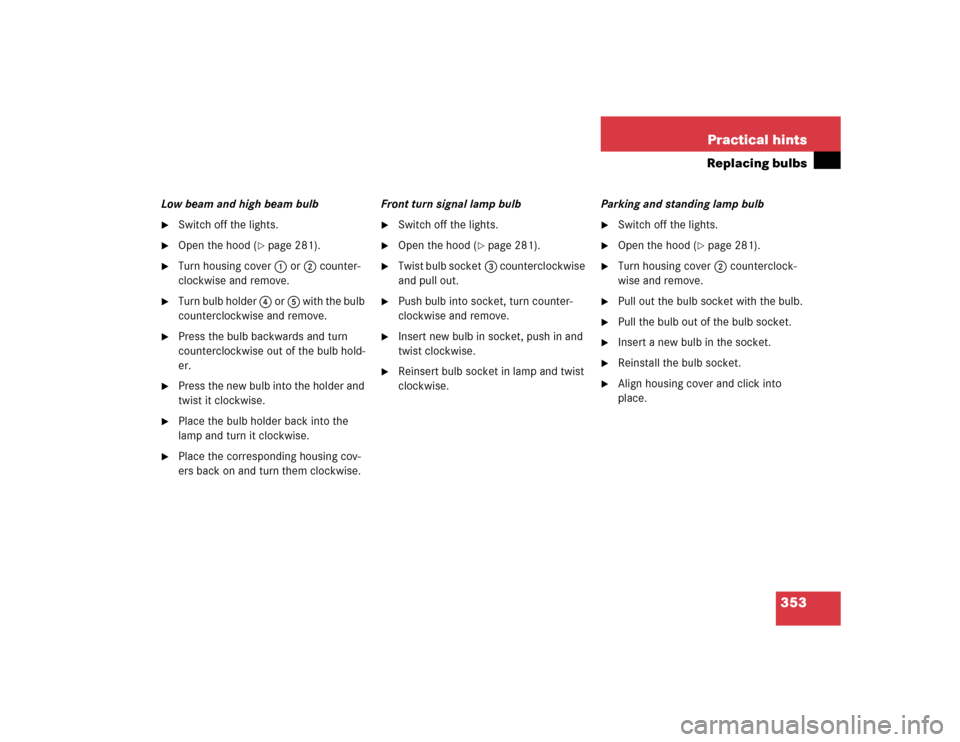
353 Practical hints
Replacing bulbs
Low beam and high beam bulb�
Switch off the lights.
�
Open the hood (
�page 281).
�
Turn housing cover1 or 2 counter-
clockwise and remove.
�
Turn bulb holder 4 or 5 with the bulb
counterclockwise and remove.
�
Press the bulb backwards and turn
counterclockwise out of the bulb hold-
er.
�
Press the new bulb into the holder and
twist it clockwise.
�
Place the bulb holder back into the
lamp and turn it clockwise.
�
Place the corresponding housing cov-
ers back on and turn them clockwise.Front turn signal lamp bulb
�
Switch off the lights.
�
Open the hood (
�page 281).
�
Twist bulb socket3 counterclockwise
and pull out.
�
Push bulb into socket, turn counter-
clockwise and remove.
�
Insert new bulb in socket, push in and
twist clockwise.
�
Reinsert bulb socket in lamp and twist
clockwise.Parking and standing lamp bulb
�
Switch off the lights.
�
Open the hood (
�page 281).
�
Turn housing cover2 counterclock-
wise and remove.
�
Pull out the bulb socket with the bulb.
�
Pull the bulb out of the bulb socket.
�
Insert a new bulb in the socket.
�
Reinstall the bulb socket.
�
Align housing cover and click into
place.
Page 356 of 440
356 Practical hintsReplacing bulbsReplacing bulbs for rear lamps
Tail lamp assemblies
1Brake lamp
2Turn signal lamp
3Backup lamp
4Standing and side marker lamp
5Rear fog lamp (driver’s side)/tail�
Switch off the lights.
�
Open trunk.
�
Swing the trim panel covering the cor-
responding rear lights to the side.
�
Squeeze tabs together and remove the
bulb holder with the bulb.
�
Twist bulb counterclockwise and pull
out of bulb holder.
�
Insert new bulb into the holder and turn
it clockwise.
�
Reinstall bulb holder. The tabs must au-
dibly click.
�
Close trim panel.
�
Place the housing cover back on so
that its tabs click in place. License plate lamp
1Screws
�
Switch off the lights.
�
Loosen both screws1 and remove
lamp.
�
Replace the tubular lamp and reinstall
lamp.
�
Retighten the screws.
Page 368 of 440
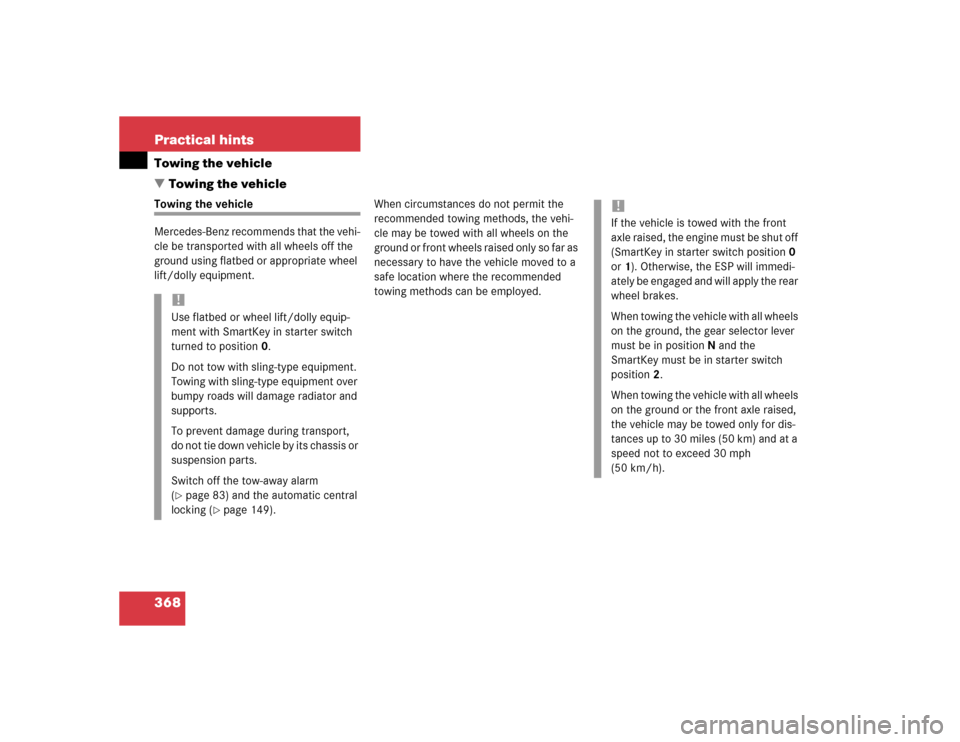
368 Practical hintsTowing the vehicle
�Towing the vehicleTowing the vehicle
Mercedes-Benz recommends that the vehi-
cle be transported with all wheels off the
ground using flatbed or appropriate wheel
lift/dolly equipment.When circumstances do not permit the
recommended towing methods, the vehi-
cle may be towed with all wheels on the
ground or front wheels raised only so far as
necessary to have the vehicle moved to a
safe location where the recommended
towing methods can be employed.
!Use flatbed or wheel lift/dolly equip-
ment with SmartKey in starter switch
turned to position0.
Do not tow with sling-type equipment.
Towing with sling-type equipment over
bumpy roads will damage radiator and
supports.
To prevent damage during transport,
do not tie down vehicle by its chassis or
suspension parts.
Switch off the tow-away alarm
(�page 83) and the automatic central
locking (
�page 149).
!If the vehicle is towed with the front
axle raised, the engine must be shut off
(SmartKey in starter switch position0
or1). Otherwise, the ESP will immedi-
ately be engaged and will apply the rear
wheel brakes.
When towing the vehicle with all wheels
on the ground, the gear selector lever
must be in positionN and the
SmartKey must be in starter switch
position2.
When towing the vehicle with all wheels
on the ground or the front axle raised,
the vehicle may be towed only for dis-
tances up to 30 miles (50 km) and at a
speed not to exceed 30 mph
(50 km/h).
Page 380 of 440
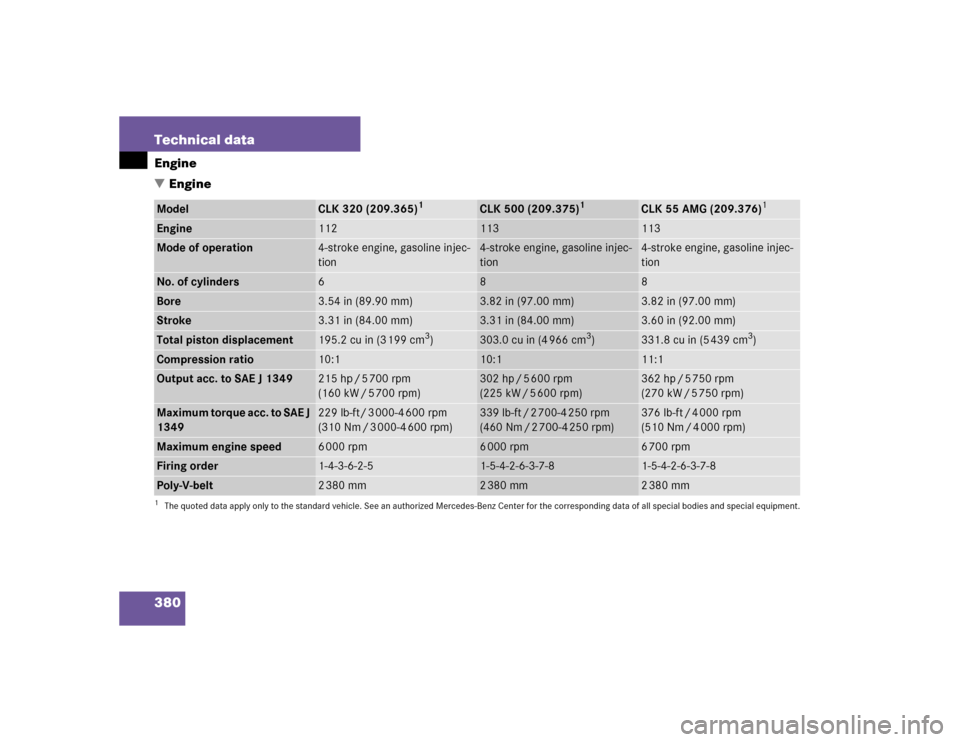
380 Technical dataEngine
�EngineModel
CLK 320 (209.365)
1
1The quoted data apply only to the standard vehicle. See an authorized Mercedes-Benz Center for the corresponding data of all special bodies and special equipment.
CLK 500 (209.375)
1
CLK 55 AMG (209.376)
1
Engine
112
113
113
Mode of operation
4-stroke engine, gasoline injec-
tion
4-stroke engine, gasoline injec-
tion
4-stroke engine, gasoline injec-
tion
No. of cylinders
6
8
8
Bore
3.54 in (89.90 mm)
3.82 in (97.00 mm)
3.82 in (97.00 mm)
Stroke
3.31 in (84.00 mm)
3.31 in (84.00 mm)
3.60 in (92.00 mm)
Total piston displacement
195.2 cu in (3 199 cm
3)
303.0 cu in (4 966 cm
3)
331.8 cu in (5 439 cm
3)
Compression ratio
10:1
10:1
11:1
Output acc. to SAE J 1349
215 hp / 5 700 rpm
(160 kW / 5 700 rpm)
302 hp / 5 600 rpm
(225 kW / 5 600 rpm)
362 hp / 5 750 rpm
(270 kW / 5 750 rpm)
Maximum torque acc. to SAE J
1349
229 lb-ft/ 3 000-4 600 rpm
(310 Nm / 3 000-4 600 rpm)
339 lb-ft / 2 700-4 250 rpm
(460 Nm / 2 700-4 250 rpm)
376 lb-ft / 4 000 rpm
(510 Nm / 4 000 rpm)
Maximum engine speed
6000 rpm
6 000 rpm
6700 rpm
Firing order
1-4-3-6-2-5
1-5-4-2-6-3-7-8
1-5-4-2-6-3-7-8
Poly-V-belt
2380 mm
2 380 mm
2380 mm
Page 388 of 440
388 Technical dataFuels, coolants, lubricants, etc.
�Fuels, coolants, lubricants, etc.CapacitiesVehicle components and their respective
lubricants must match. Therefore only use
brands tested and approved by
Mercedes-Benz.Please refer to the Factory Approved Ser-
vice Products pamphlet, or inquire at your
Mercedes-Benz Center.
Model
Capacity
Fuels, coolants, lubricants, etc.
Engine with oil filter
CLK 320
CLK 500
CLK 55 AMG
8.5 US qt (8.0 l)
8.0 US qt (7.5 l)
9.0 US qt (8.5 l)
Approved engine oils
Automatic transmission
CLK 320
CLK 500
CLK 55 AMG
8.0 US qt (7.5 l)
9.3 US qt (8.7 l)
9.3 US qt (8.7 l)
MB Automatic Transmission Oil
Rear axle
CLK 320
CLK 500
CLK 55 AMG
1.28 US qt (1.2 l)
1.5 US qt (1.4 l)
1.5 US qt (1.4 l)
Hypoid gear oil SAE 85 W 90
Power steering
approx. 1.1 US qt (1.0 l)
MB Power Steering Fluid (Pentosin
CHF 11S)
Front wheel hubs
approx. 3.0 oz (85 g) each
High temperature roller bearing grease
Brake system
0.64 US qt (0.6 l)
MB Brake Fluid (DOT 4+)
Page 391 of 440
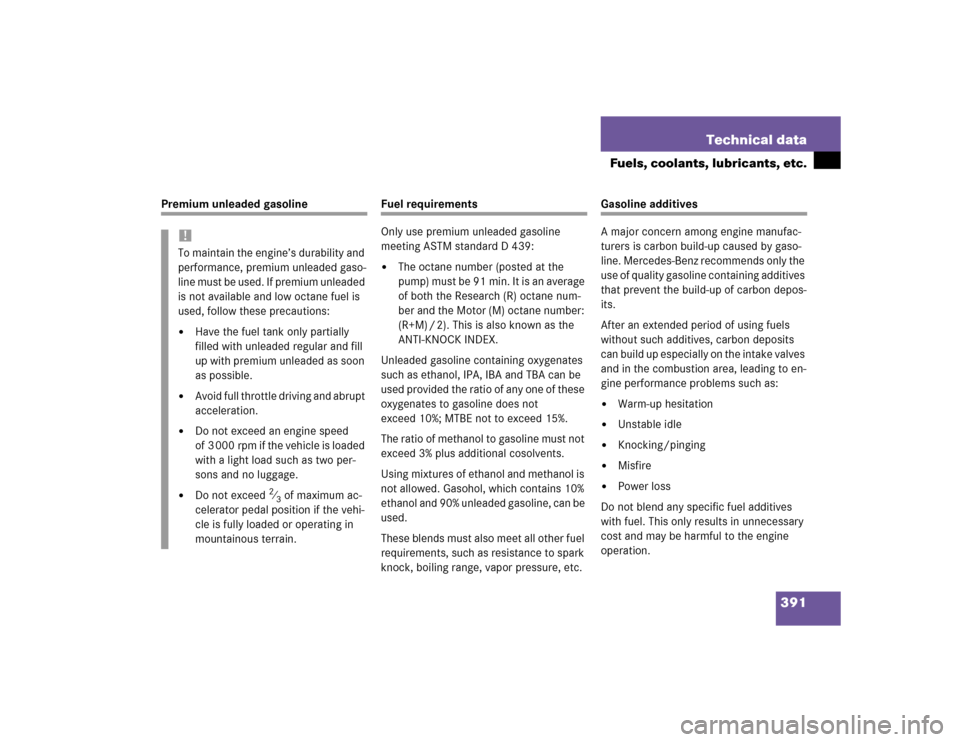
391 Technical data
Fuels, coolants, lubricants, etc.
Premium unleaded gasoline
Fuel requirements
Only use premium unleaded gasoline
meeting ASTM standard D 439:�
The octane number (posted at the
p um p) m us t be 91 mi n. It i s an a vera ge
of both the Research (R) octane num-
ber and the Motor (M) octane number:
(R+M) / 2). This is also known as the
ANTI-KNOCK INDEX.
Unleaded gasoline containing oxygenates
such as ethanol, IPA, IBA and TBA can be
used provided the ratio of any one of these
oxygenates to gasoline does not
exceed 10%; MTBE not to exceed 15%.
The ratio of methanol to gasoline must not
exceed 3% plus additional cosolvents.
Using mixtures of ethanol and methanol is
not allowed. Gasohol, which contains 10%
ethanol and 90% unleaded gasoline, can be
used.
These blends must also meet all other fuel
requirements, such as resistance to spark
knock, boiling range, vapor pressure, etc.
Gasoline additives
A major concern among engine manufac-
turers is carbon build-up caused by gaso-
line. Mercedes-Benz recommends only the
use of quality gasoline containing additives
that prevent the build-up of carbon depos-
its.
After an extended period of using fuels
without such additives, carbon deposits
can build up especially on the intake valves
and in the combustion area, leading to en-
gine performance problems such as:�
Warm-up hesitation
�
Unstable idle
�
Knocking/pinging
�
Misfire
�
Power loss
Do not blend any specific fuel additives
with fuel. This only results in unnecessary
cost and may be harmful to the engine
operation.
!To maintain the engine’s durability and
performance, premium unleaded gaso-
l i n e m u s t b e u s e d . I f p r e m i u m u n l e a d e d
is not available and low octane fuel is
used, follow these precautions:�
Have the fuel tank only partially
filled with unleaded regular and fill
up with premium unleaded as soon
as possible.
�
Avoid full throttle driving and abrupt
acceleration.
�
Do not exceed an engine speed
of 3 000 rpm if the vehicle is loaded
with a light load such as two per-
sons and no luggage.
�
Do not exceed
2⁄3 of maximum ac-
celerator pedal position if the vehi-
cle is fully loaded or operating in
mountainous terrain.
Page 396 of 440
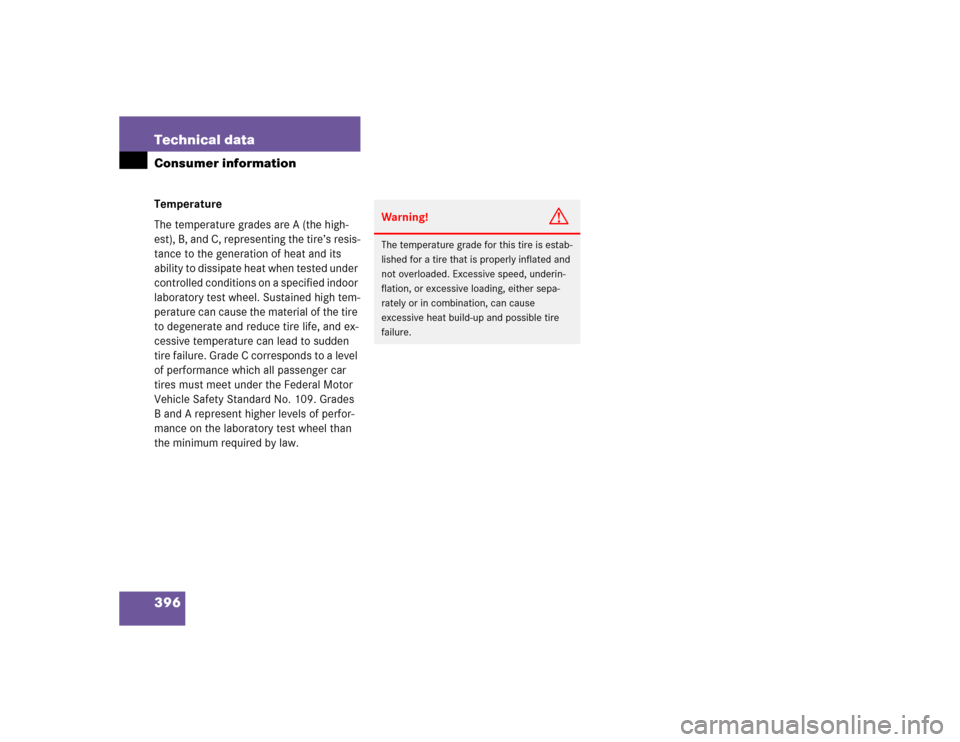
396 Technical dataConsumer informationTemperature
The temperature grades are A (the high-
est), B, and C, representing the tire’s resis-
tance to the generation of heat and its
ability to dissipate heat when tested under
controlled conditions on a specified indoor
laboratory test wheel. Sustained high tem-
perature can cause the material of the tire
to degenerate and reduce tire life, and ex-
cessive temperature can lead to sudden
tire failure. Grade C corresponds to a level
of performance which all passenger car
tires must meet under the Federal Motor
Vehicle Safety Standard No. 109. Grades
B and A represent higher levels of perfor-
mance on the laboratory test wheel than
the minimum required by law.
Warning!
G
The temperature grade for this tire is estab-
lished for a tire that is properly inflated and
not overloaded. Excessive speed, underin-
flation, or excessive loading, either sepa-
rately or in combination, can cause
excessive heat build-up and possible tire
failure.